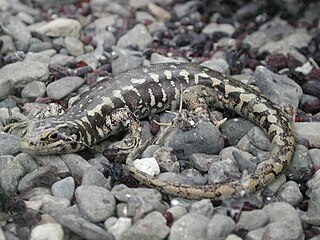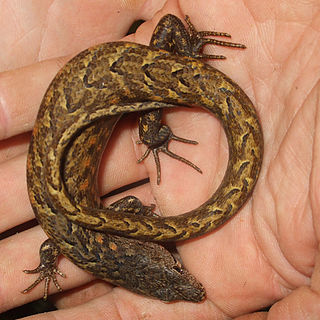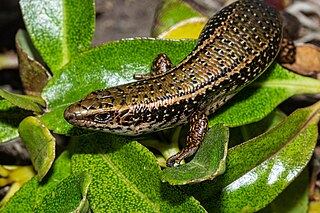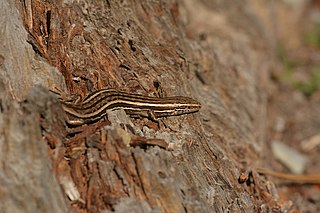
Amphiglossus is a genus of skinks, lizards in the family Scincidae.

Oligosoma is a genus of small to medium-sized skinks found only in New Zealand, Norfolk Island and Lord Howe Island. Oligosoma had previously been found to belong to the Eugongylus group of genera in the subfamily Lygosominae; the Australian genus Bassiana appears to be fairly closely related.

The copper skink is a skink of the family Scincidae that is endemic to the North Island of New Zealand.

The New Zealand striped skink is a rare species of medium-sized skink endemic to New Zealand. Found in the North Island, Great Barrier Island and Little Barrier Island, the species is primarily arboreal, living in dense native tree canopies.

Oligosoma alani,, also known as the robust skink is the largest endemic skink to New Zealand. The robust skink is in the family Scincidae and found in the protected nature reserves of the Mercury Islands in the North Island of New Zealand. The robust skink has an at risk - recovering conservation status.

McGregor's skink is a species of lizard in the family Scincidae. The species is endemic to New Zealand.

The marbled skink is a species of skink in the family Scincidae. The species is endemic to New Zealand.

Whitaker's skink, also known commonly as Whitaker's New Zealand skink, is an endangered species of skink, a lizard in the family Scincidae. The species is found only in New Zealand.

Falla's skink, also known commonly as the Three Kings skink, is a species of lizard in the family Scincidae. The species is native to New Zealand.

The chevron skink is a large species of skink that is endemic to New Zealand. Previously found across Northland and the northern Auckland Region, it is now found only on the Great Barrier and Little Barrier islands in the Hauraki Gulf. A cryptic forest dweller, it can hide underwater. The chevron skink is the longest species of skink in New Zealand, reaching lengths of up to 340 mm (13 in). It is under threat from introduced rats.

Oligosoma nigriplantare, the Chatham Islands skink, is a species of skink in the family Scincidae.

Oligosoma suteri, known commonly as Suter's skink, the black shore skink, the egg-laying skink, and Suter's ground skink, is a species of lizard in the family Scincidae. The species is endemic to New Zealand, found in fragmented populations on the mainland of the Coromandel Peninsula as far south as the Coromandel Peninsula, and on offshore northern islands of New Zealand.

Hardy's skink is a species of skink, a lizard in the family Scincidae. The species is endemic to the Poor Knights Islands of New Zealand.

The Mokohinau skink, also known commonly as Towns' skink and the Hauraki skink, is a species of lizard in the family Scincidae. The species is endemic to New Zealand.

The Aorangi skink is a species of lizards in the skink family. The species is native to New Zealand.

The Burgan skink is a nationally endangered species of skink native to New Zealand. It was described from a specimen found near the Burgan Stream, in the Rock and Pillar Range, Central Otago.

Oligosoma lineoocellatum, commonly known as the Canterbury spotted skink, is one of a species complex of several related spotted skink species from New Zealand.

The McCann's skink is a species of skink native to New Zealand.

The Chesterfield or Kapitia skink is a species of skink found in New Zealand. Only discovered in 1994 and for years not recognised as a distinct species, it is endemic to a narrow 1 km strip of coastal vegetation on the West Coast of New Zealand, 15 km north of Hokitika. There are fewer than 200 individuals remaining in the wild. Oligosoma salmo is the only New Zealand skink with a prehensile tail, suggesting it was once arboreal and inhabited coastal forest, which was subsequently cleared for dairy farming. Following the partial destruction of its remaining habitat in 2018 by a cyclone, a small captive breeding population was established at Auckland Zoo.
The tātahi skink is an undescribed skink species endemic to New Zealand in the family Scincidae, found on the western coast of the Northland Peninsula and Manawatāwhi / Three Kings Islands in New Zealand. Thought to be the same species as Oligosoma smithi of the east coast, the Tātahi skink was identified as being genetically distinct in 2008.




















